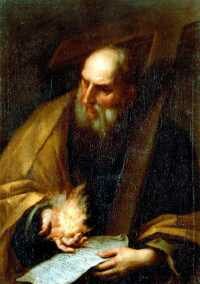
Paul the Apostle, also known as Paul, Paulus, Paul of Tarsus, and Saint Paul the Apostle, (AD 3—67) is widely considered to be central to the early development and spread of Christianity, particularly westward from Judea. Many Christians view him as an important interpreter of the teachings of Jesus. Paul is described in the New Testament as a Hellenized Jew and Roman citizen from Tarsus (present-day Turkey), and as a persistent persecutor of early Christians, almost all of whom were Jewish, prior to his "Road to Damascus" experience, which brought about his conversion to faith in Jesus as Messiah, not only for Jews, but for all, regardless of ethnic background.
Paul made the first great effort, through his Epistles to Gentile Christian communities, to show that the God of Abraham is for all people, rather than for Jews only, though he did not originate the idea, for example see Isaiah 56:6-8 or proselyte or Great Commission, or Simon Peter's vision of the sheet descending from Heaven in Acts 10:9-23a.
Paul is venerated as a Saint by all the churches that honor saints, including those of the Roman Catholic, Eastern Orthodox, and Anglican traditions, and some Lutheran sects.
He is the 'patron saint' of the City of London and has also had several cities named in his honor, including Sao Paulo, Brazil and Saint Paul, Minnesota in the United States. He did much to advance Christianity among the Gentiles, and is considered to be one source (if not the primary source) of early Church doctrine, and the founder of Pauline Christianity. His epistles form a fundamental section of the New Testament. Some argue that he was instrumental in establishing Christianity as a distinct religion, rather than a sect of Judaism, as Christianity was first known.
Due to his body of work and his undoubted influence on the development of Christianity, some modern scholars have considered Paul to be the founder of Christianity, who modified Jesus' teachings and added important new doctrines. However, this view remains controversial. Most Christian scholars say that no teachings were modified, and assert that Paul taught in complete harmony with Jesus. Some Christians, however, particularly those who embrace dispensationalism, believe that Jesus' teachings are for the Jews — especially those teachings found in Matthew — and that Christians necessarily have a different belief system since Christianity, according to this perspective, only arose as a result of the rejection by the Jews of Jesus as their Messiah.
 The history of Christianity concerns the history of the Christian religion and the Church, from Jesus and his Twelve Apostles to contemporary times. Christianity is the monotheistic religion which considers itself based on the revelation of Jesus Christ (cf. Galatians 1:12). "The Church" is understood theologically as the institution founded by Jesus for the salvation of mankind.
The history of Christianity concerns the history of the Christian religion and the Church, from Jesus and his Twelve Apostles to contemporary times. Christianity is the monotheistic religion which considers itself based on the revelation of Jesus Christ (cf. Galatians 1:12). "The Church" is understood theologically as the institution founded by Jesus for the salvation of mankind.


























